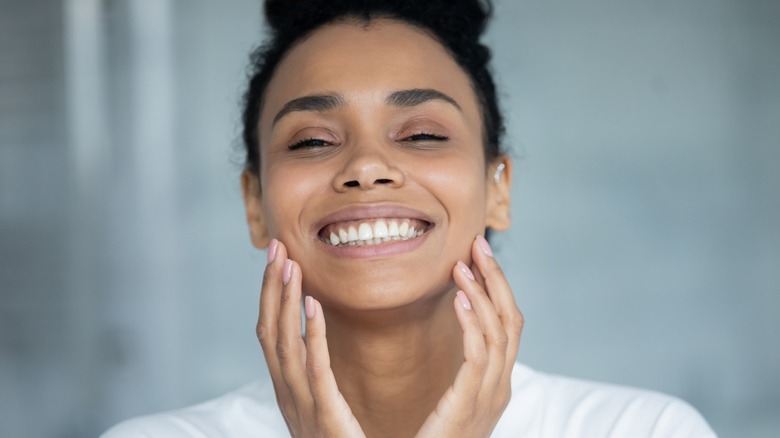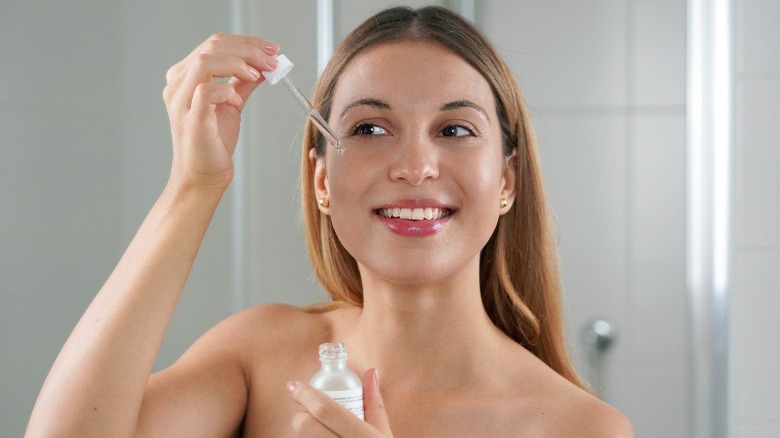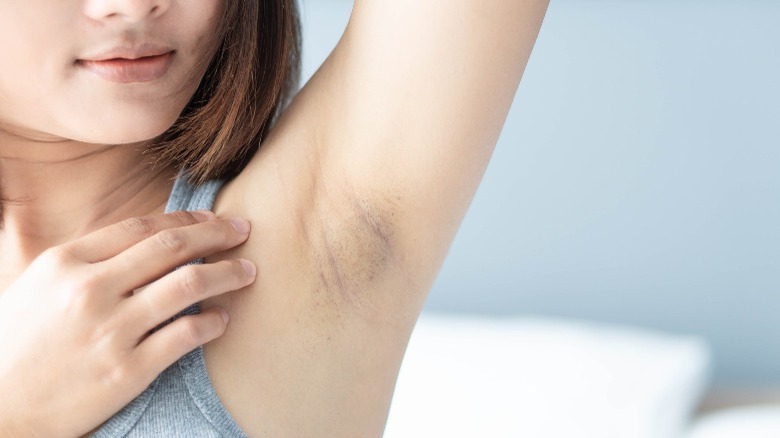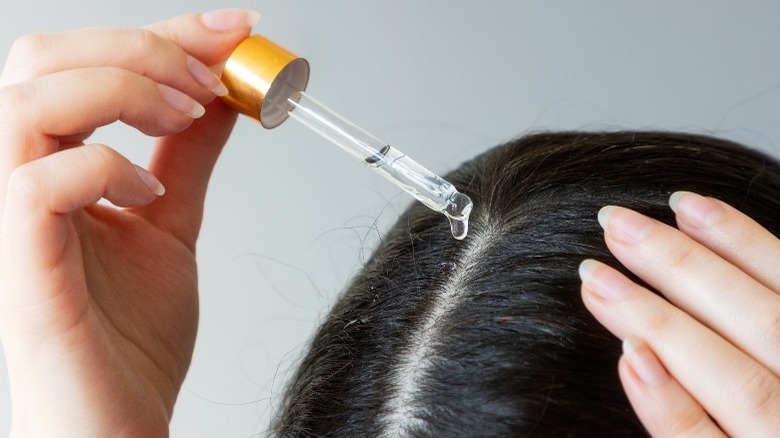Glycolic Acid Can Benefit Your Beauty Routine From Head To Toe (Literally)
We love skincare products that have more than just one purpose, giving us more value for our hard-earned dollar, and assisting us in tackling multiple beauty concerns at once. Glycolic acid is one such ingredient. Glycolic acid is an alpha-hydroxy acid, otherwise known as an AHA. You might have also heard of its counterpart, beta-hydroxy acid (BHA) since the two are frequently used together. Both acids are exfoliants, but the main difference between them is in their solubility. Where AHAs are water-soluble, BHAs are oil-soluble, meaning that AHAs can be gentle and suitable for most skin types, whereas BHAs penetrate deeper into the skin, suitable for those with acne-prone skin.
Glycolic acid, which is made from processed sugarcane, has the lowest molecular weight of other types of AHAs, including citric acid and lactic acid, meaning it is absorbed into the skin with ease. Because of its water-solubility and lightweight nature, glycolic acid is a highly versatile ingredient, and skincare lovers have caught on to its many benefits. From sloughing dead cells to bolstering hair repair, glycolic acid can boost your beauty routine from head to toe — but keep in mind, some of its uses are more effective than others.
Glycolic acid for the face
One of the most common uses of glycolic acid is on the face. As an exfoliant, glycolic acid can assist in washing away dead skin skills that could otherwise clog your pores, or dull the shine of your skin. But glycolic acid is not just an exfoliant; it also moisturizes the skin, treats hyperpigmentation, and reduces the appearance of fine lines. Lower concentrations of glycolic acid are safe for everyday use, while glycolic face masks can be used at a higher concentration around once or twice a week.
Remember that glycolic acid is still, well, an acid, so take care to use the ingredient at night or with adequate sunscreen because exposure to the sun can cause skin sensitivity and heightened exposure to UV rays. (The Food and Drug Association notes that using AHA increases UV sensitivity, but that this is completely reversible by discontinuing use.) Instead, ease your way into consistent use of glycolic acid to avoid irritation. Also note that using glycolic acid in the same routine as a retinol or retinoid product is typically not a great idea, as both are powerful exfoliants. Opt for alternating between the two on different days.
Glycolic acid is for the feet
Because of glycolic acid's exfoliating and hydrating properties, it can also be a helpful remedy for those who want to step up their foot care routine. Having cracked or flakey feet is super common, especially in the warmer months when our feet are out and about in sandals, soaking in the sun. But using a product with glycolic acid could provide some assistance! Apply a lotion with glycolic acid to the thicker patches of dry skin, like the heels, or use glycolic acid concentrate. Then, follow up with a moisturizer or foot balm, and you're good to go.
This foot care "hack" went viral on TikTok. Dr. Lindsay (@dermguru) shared the step-by-step process in the above video. Right after showering, use a cotton pad to swipe your feet with a glycolic acid product; she uses the 7% glycolic acid toner from The Ordinary. Without washing it off, apply Vaseline to the feet, and seal the deal with some cotton socks. Be cautious, however, if your feet are significantly cracked because the glycolic acid could be irritating — and who wants irritated feet? In more severe cases, see a dermatologist for proper care, or choose a gentler exfoliating option such as soaking the feet and rubbing them with a physical exfoliant before moisturizing.
Glycolic acid is NOT for your underarms
While TikTok can be full of amazing ideas, putting glycolic acid on your underarms is unfortunately not one of them. Some TikTok creators have been using glycolic acid under the arms to mitigate odor as a replacement to deodorant, and even lighten the underarm area (spoiler alert, it can actually do the opposite). Remember that deodorant is not the same thing as an antiperspirant, which stops sweating, though the two are often combined in one product. While the logic sounds good in theory — glycolic acid could kill the bacteria that cause underarm odor — because the skin in your armpits is highly sensitive, you could be doing more damage to your skin than it's worth.
Experts speaking with Byrdie advise against glycolic acid in the underarms because it can irritate the skin, cause a rash, and even cause hyperpigmentation — especially for those with sensitive skin. The truth about using glycolic acid on your underarms is that there are plenty of alternatives specifically designed to tackle underarm odor, without the risk of irritating or even damaging your skin. While glycolic acid can be used for a great number of skin-care benefits, use in the pits is simply not one of them.
Glycolic acid can treat ingrown hairs
Glycolic acid can, however, be used in other sensitive body areas, including the bikini line. Because glycolic acid is a gentle exfoliant, it can be phenomenal for those who are prone to ingrown hairs. Exfoliation is essential when it comes to proper hair regrowth. Ingrown hairs can happen anywhere your hair is growing, but specifically on the legs and groin area of the body — even, dare we mention, on the booty. Applying glycolic acid after shaving helps to ensure that your hair has a clear pathway through the skin as it grows back. Just remember to use a small amount of a low concentration of glycolic acid in sensitive areas to avoid damaging your skin.
TikTok creator and esthetician Isabella Traboscia (@elevenesthetician) says in the above TikTok video that she struggles with razor burn and ingrown hairs on her leg. She discovered that using a lotion with glycolic acid in it after shaving — she mentions the lotion from Drunk Elephant — and following up with another body moisturizer has made her legs super smooth.
Glycolic acid can strengthen hair
You might be surprised to learn that, in addition to its skincare benefits, glycolic acid can also benefit our hair and scalp. Specifically, glycolic acid helps with lifting away dead skin cells and moisturizing the scalp. Glycolic acid also helps address excess oil on the scalp, perfect for those who struggle with increased greasiness. However, use caution if your scalp is sensitive or prone to itchiness, as glycolic acid could potentially make this problem worse.
Glycolic acid can also work on the hair itself, where it can be used in a low concentration to help strengthen and moisturize the hair. However, due to its acidity, overdoing one's usage of glycolic acid on the hair can actually damage hair long-term, causing the very breakage that with moderation, glycolic acid can protect from. Instead, opt for using glycolic on the acid no more than once a week, and potentially even less frequently, depending on how your hair and scalp respond. Should you be particularly concerned about hair breakage and your scalp health, consult a dermatologist to create a treatment plan tailored to you.



